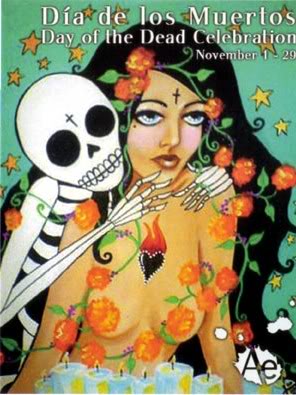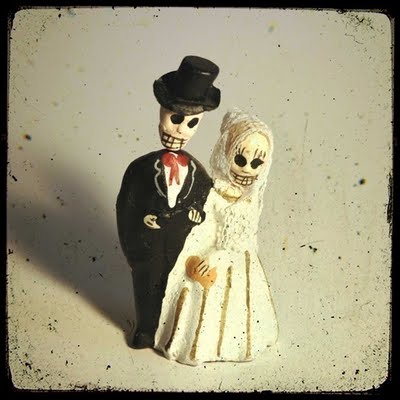How to Have an Amazing Dia de los Muertos
So maybe your Halloween sucked. Maybe you spent all day dressing up to find that the one dude or dudette you planned on going home with was more into the sexy nun than you. Or maybe no one got the obscure comic book reference for your costume but members of the gender you were NOT trying to attract. Have no fear. Today brings a new day, and a new holiday to celebrate! El Dia de los Muertos. Day of the Dead.
Now besides being the title of a cult classic horror movie, Day of the Dead is also a holiday marking the day that departed souls are believed to return to earth. Celebrated on November 1st and 2nd, Dia de los Muertos might at first hit you as a pretty morbid affair. However, in Mexican culture, this is a delightful celebration filled with live music, food, colorful decorations, and family. Octavio Paz notes that a Mexican person generally reacts very differently to death than an American does, in fact he “chases after it, mocks it, courts it, hugs it, sleeps with it; it is his favorite plaything and his most lasting love.” Instead of trying to ignore death, Day of the Dead is a beautiful festival filled with lively rituals to honor ancestors and dead loved ones.
Day of the Dead evolved out of a combination of Aztec (and other Meso-American civilizations) and Roman Catholic practices and beliefs. Many pre-Hispanic peoples viewed life as a dream and believed that only in death did one become truly awake. Their celebration of death freaked out the Spanish Conquistadors, but they were unable to eradicate it. They did manage to move the holiday to coincide with All Saints’ Day and All Souls’ Day. While Day of the Dead is celebrated differently all over the Americas, all traditions share a sense of tremendous pride for the work that goes into honoring the dead.
For your Dia de los Muertos celebration, you are going to need a few things. Because the spirits of the dead who visit you will need sustenance for their journey back to the dead-people realm, you really should provide them with some of their favorite dishes and delicious goodies, plus it wouldn’t hurt to show them a good time with decorations, color, and flowers. Two common rituals that go into a Dia de los Muertos celebration are creating ofrendas, or altars, in your home or cemetery and visiting your loved ones’ burial plots.
In creating your altar, try to touch on the four main elements of nature '“ earth, wind, water, and fire. It is believed that souls are fed by the aroma of food, and the crops that go into making these dishes represent earth. Papel picados, colorful strings of tissue paper cutouts, represent wind. A glass of water to quench the soul’s thirst represents just that, water. And, candles (usually one per soul, with an extra one placed for any forgotten souls) represent fire. Altars are covered with the fragrant cempasúchil flower, or orange marigold, whose scent is used to guide the souls back. Moles (or thick sauces made from a variety of ingredients, including chilies, sesame seeds, herbs, spices, chocolate, and fruit), tamales, sweets like the edible sugar skulls (calaceritas de azúcar), pumpkin candy, and other traditional desserts decorate the altars. Non-spicy versions of adult dishes will even be found for children who have died, angelitos (or little angels). A unique Pan de Muerto, Day of the Dead bread, made with flour, butter, sugar, eggs, orange peel, anise, and yeast, is also set out. The bread is adorned with strips of dough that resembles bones, crosses, or teardrops. You’ll find all varieties of items, including skeletons, dolls, macabre toys, fruits, vegetables, incense (burnt copal), statues of saints, photos of the deceased, wreaths, crosses, even bottles of alcoholic mescal, beer, soda, and the traditional atole (a corn gruel, also known as the 'œoriginal power bar' for its nourishing qualities). Ofrendas seem to be open to interpretation, and creativity is always celebrated!
The second ritual that is common to the Day of the Dead is visiting the graves of your ancestors. Now, I have to admit, I have no idea where most of my ancestors were buried as family plots aren’t so common any more, but there can’t be much harm in going to a cemetery and choosing one or two tombstones to (tastefully) decorate, right? Think of it as a random good deed for a deceased stranger. Traditionally, families will decorate the graves of loved ones with candles, marigolds, bottles of tequila, and altars. Family members will clean the graves, sing songs, set up hundreds of candles, reminisce about their loved ones, pray and reflect. Picnics are laid out, mariachi bands play, and sometimes even fireworks are involved! For the most part, however, it is a quiet and wondrous affair.
Besides the homemade sweets and steaming dishes, the Tim Burton-esque skeleton statues, and the colors and crafts, what delights me about the tradition of Dia de los Muertos is the fact that people are allowed to enjoy the inevitable. Let’s face it. The one thing we can count on for each of our futures is that we will die. Wouldn’t death just seem so much less frightening if you knew your friends would celebrate you once you’re gone? It’s an old-fashioned tradition for our modern American culture – honoring our ancestors '“ but to my thinking, it might just be something we want to reinstate. Get your friends together, head to your nearest bodega, and celebrate today as if it was your last! (Seriously. It might just be. And that’s ok.)
For Recipes and DIY Craft Instructions, check out these links:
Recipes:
Pan de Muerto
Calabaza en Tacha (Pumpkin Candy)
Fruit Atole
Candy Skulls
Mole Poblano
White Chocolate Mole
Crafts:
Day of the Dead Wire and Clay Sculpture
La Calavera Lino Cut Memory Cards
Easy Paper Flowers
Day of the Dead Sugar Skulls
Matchbook Shrines
Further Reading:
MexConnect '“ Day of the Dead Resource Page
Day of the Dead History
El Dia de Muertos
Traditions: The Altar
Day of the Dead Food
Day of the Dead in Mexico
Day of the Dead Glossary





